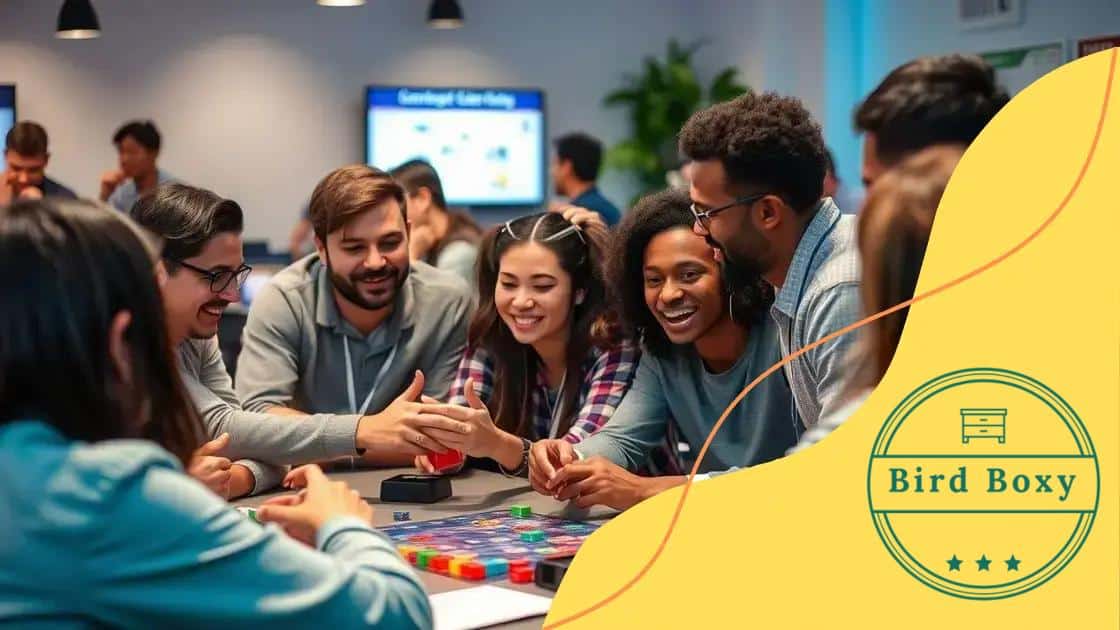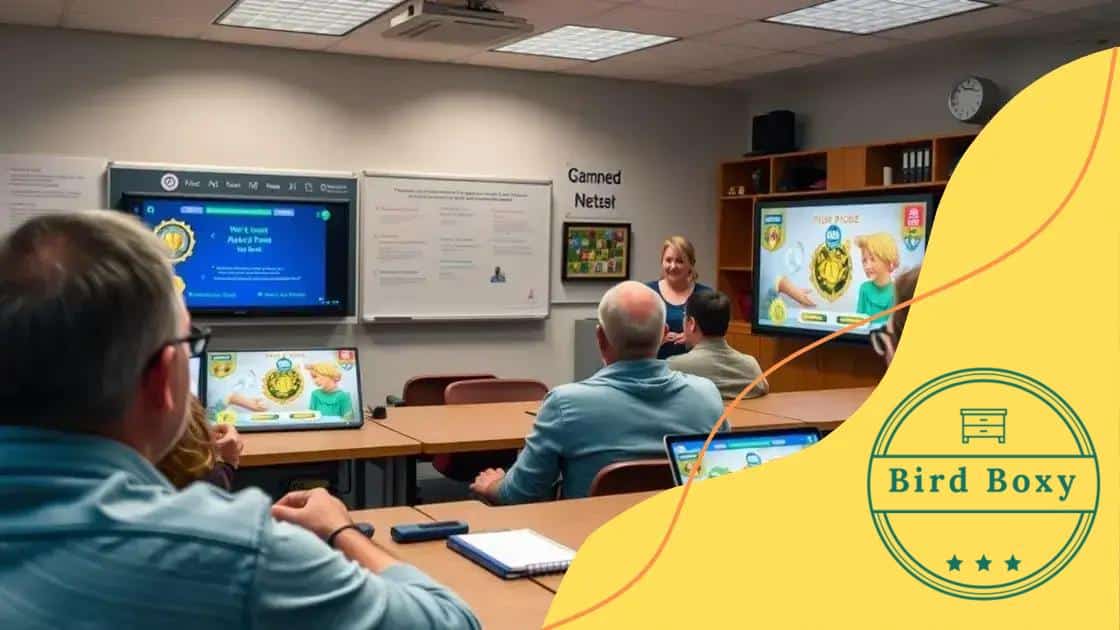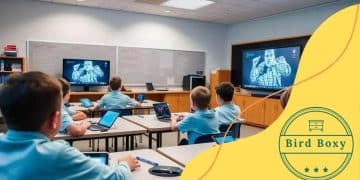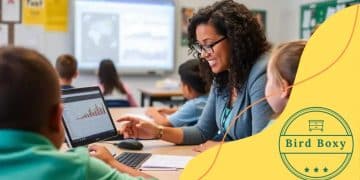Gamification of adult learning: unlocking engagement

The gamification of adult learning incorporates game design elements to enhance engagement, motivation, and knowledge retention, overcoming challenges like resistance to change and resource constraints.
Gamification of adult learning has emerged as a powerful tool to boost engagement and motivation. Have you ever wondered how game elements can transform traditional learning into an exciting adventure? Let’s dive into this innovative approach and explore its potential.
Understanding gamification in education
Understanding gamification in education can transform traditional learning methods into engaging experiences. By integrating game-like elements, educators can motivate adult learners and make education more interactive.
What is Gamification?
Gamification refers to the application of game design principles in non-game contexts, especially in learning environments. It involves adding elements such as points, badges, and challenges to enhance the educational experience.
Benefits of Gamification
- Increases engagement: By making learning fun, students are more likely to participate actively.
- Enhances motivation: The elements of competition and achievement can drive learners to excel.
- Promotes retention: Interactive and enjoyable experiences help ensure that knowledge is retained longer.
- Encourages collaboration: Gamified practices often include group activities that foster teamwork and communication skills.
Many institutions have seen positive outcomes from implementing gamification strategies. For instance, courses that use quizzes with leaderboards can motivate students to perform better. When learners receive immediate feedback through gamified assessments, they can adjust their approaches quickly.
Furthermore, when tasks are viewed as challenges rather than chores, adult learners often exhibit greater enthusiasm toward their studies. This mindset shift is essential for effective learning and personal growth. By leveraging the principles of game design, educators can create an environment where adult learners feel empowered.
Benefits of gamification for adult learners
The benefits of gamification for adult learners are significant and can greatly enhance the learning process. By introducing game-like elements, adults are more likely to engage and succeed in their educational pursuits.
Increased Motivation
Gamification creates a fun and competitive environment, which can spark a higher level of motivation. Adult learners often juggle many commitments, so making learning enjoyable helps keep their interest alive.
Improved Retention Rates
When concepts are presented through interactive activities, students are more inclined to remember the material. Incorporating game mechanics can lead to better retention rates among learners.
- Progress Tracking: Adults can visualize their achievements through badges or points.
- Immediate Feedback: Gamification provides instant responses, allowing learners to adjust their strategies quickly.
- Real-world Relevance: Games often simulate real-life scenarios, making lessons more applicable.
As learners interact with gamified content, they not only grasp concepts quicker but also enjoy the experience more. The use of games and challenges also helps create a sense of community among participants, fostering collaboration and support.
Additionally, adult learners often seek to apply their knowledge in practical ways. Gamification facilitates this by encouraging learners to practice skills in a risk-free environment. This method promotes confidence, as learners can experiment and receive feedback without the fear of failure.
Key elements to incorporate in gamification

Understanding the key elements to incorporate in gamification can make a significant difference in how effectively it engages learners. By focusing on specific components, educators can design an enriching experience for adult learners.
Game Mechanics
Incorporating game mechanics is essential for creating a stimulating environment. These can include elements like points, badges, and leaderboards. Such features motivate learners by providing tangible rewards for their efforts.
Storytelling
Integrating storytelling into the learning experience helps learners connect with the material. When they see themselves as part of a narrative, they are more likely to engage and retain knowledge. A compelling story creates context and makes lessons relatable.
- Clear Goals: Setting clear objectives for learners helps them understand what they need to achieve.
- Challenges: Offering challenges encourages learners to push their limits and explore new skills.
- Feedback Loops: Providing timely feedback reinforces learning and helps students track their progress.
Additionally, social interaction plays a crucial role in gamification. Creating opportunities for collaboration can enhance the learning atmosphere. Whether through group tasks or friendly competitions, engaging with peers is beneficial.
As adult learners often come from diverse backgrounds, offering personalized experiences can enhance engagement. Customizable paths allow learners to select topics that resonate with them, making the process more relevant and enjoyable.
Lastly, using technology effectively amplifies gamification efforts. Leveraging digital tools can create immersive experiences that traditional methods may lack. Integrating apps, simulations, or online platforms can significantly enhance interaction.
Examples of successful gamification strategies
Exploring examples of successful gamification strategies can provide valuable insights into how different methods can enhance adult learning. Many organizations have implemented gamified approaches, resulting in noteworthy improvements in engagement and knowledge retention.
Online Learning Platforms
Online platforms like Duolingo use gamification effectively. They incorporate points, levels, and daily challenges to motivate users to practice language skills consistently. The simple interface and engaging rewards keep learners coming back.
Employee Training Programs
Companies often use gamification in training programs to improve employee skills. For instance, Deloitte introduced a gamified approach to its training sessions. Employees can earn badges and points for completing courses, leading to higher completion rates.
- Point Systems: These track progress and motivate learners through competition.
- Leaderboards: Public recognition encourages individuals to perform better.
- Interactive Scenarios: Real-life challenges provide practical application of knowledge.
Another successful example is SAP, which applied gamification in its learning management system. The program rewarded developers with badges for completing tasks, which not only enhanced learning but also built community within the workforce. This sense of achievement fosters a positive learning environment.
Moreover, some universities are adopting gamified elements in their curricula. For example, the University of Michigan added a gaming component to a business course, where students collaborated in teams to compete in market simulations. This hands-on experience facilitated deeper understanding and engagement among students.
By looking at these examples, it’s clear that effective gamification strategies can lead to increased motivation and better learning outcomes. These methods highlight the potential for creative approaches to traditional learning, making education more enjoyable and effective.
Challenges in implementing gamification
Implementing gamification in education can be effective, but there are several challenges to consider. Recognizing these obstacles is vital for developing a smooth and engaging learning experience.
Resistance to Change
One major challenge is the resistance to change among educators and learners. Many individuals are accustomed to traditional teaching methods and may be skeptical about adopting game-based techniques. To overcome this hurdle, it is important to communicate the benefits of gamification clearly.
Resource Constraints
Another challenge involves resource constraints. Many schools may lack the necessary technology or funding to implement gamified systems. In such cases, educators must get creative. Simple, low-cost gamification elements, like point systems or visual progress trackers, can be effective.
- Lack of Training: Inadequate training for instructors can hinder the successful rollout of gamified learning.
- Content Limitations: Not all subjects lend themselves well to gamification, which can limit application.
- Assessment Challenges: Measuring learning outcomes in gamified environments can be complex.
Moreover, creating engaging content that appeals to adult learners is essential. Adults come with different experiences and expectations, making it vital to design gamified activities that resonate with their professional or personal goals. This customization is crucial for achieving their desired outcomes.
It is important to keep in mind that not every gamification strategy will fit every audience. Continuous feedback and assessment of the gamified elements are key to refining the approach, ensuring that it meets the learners’ needs better over time.
FAQ – Frequently Asked Questions about Gamification in Adult Learning
What is gamification in education?
Gamification in education is the use of game design elements to enhance learning experiences, making them more engaging and interactive.
What are the main benefits of gamification for adult learners?
The main benefits include increased motivation, improved retention rates, and enhanced engagement through interactive elements.
What challenges might educators face when implementing gamification?
Challenges include resistance to change, resource constraints, and the need for adequate training for both educators and learners.
Can you provide an example of successful gamification?
Yes, platforms like Duolingo effectively use gamification by incorporating points, levels, and daily challenges to keep users engaged in language learning.






